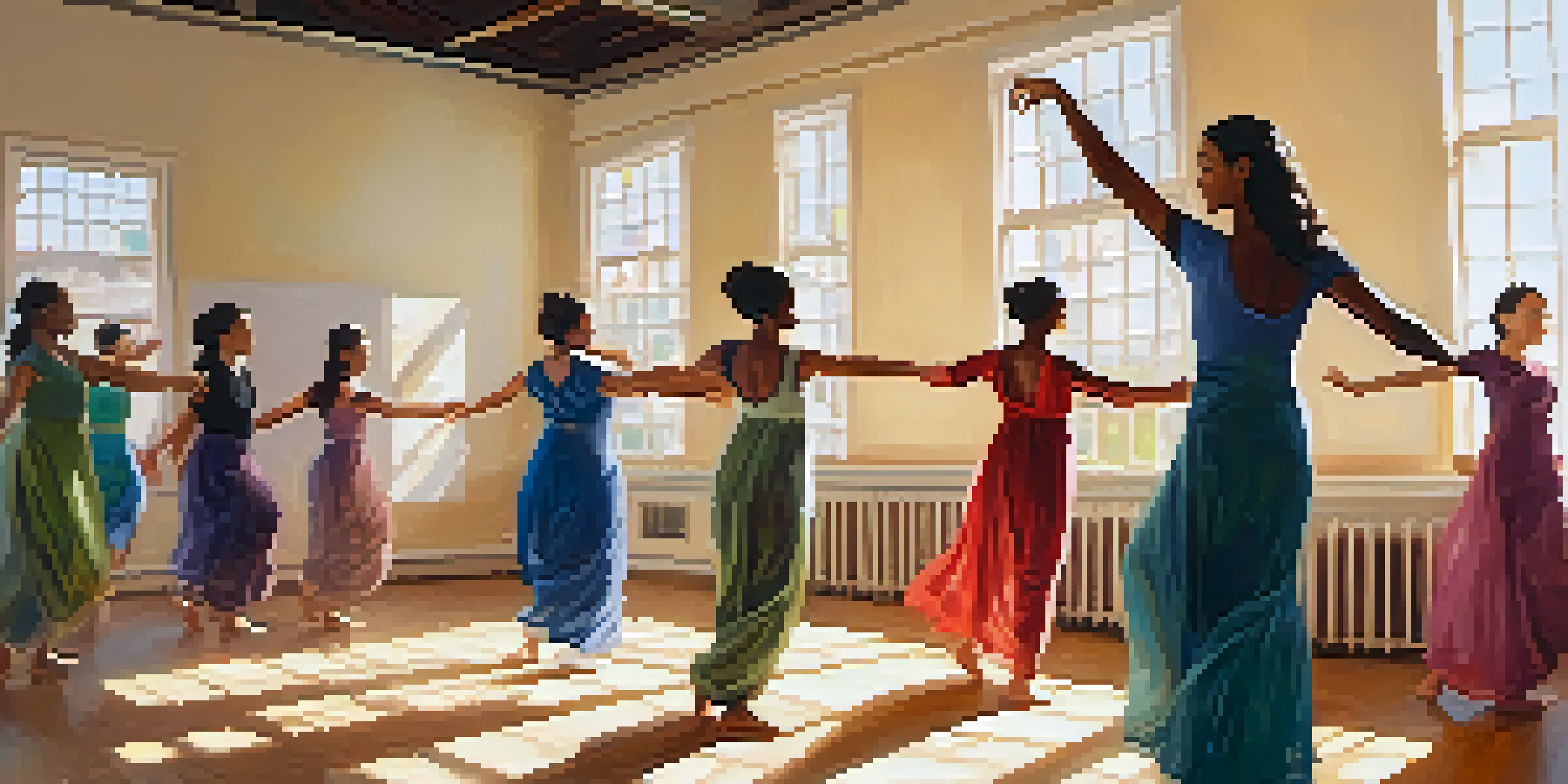The Science Behind Dance as a Therapeutic Tool

Understanding Dance Therapy and Its Origins
Dance therapy, also known as dance movement therapy, is a form of expressive therapy that uses movement to help individuals achieve emotional, cognitive, and physical integration. Its roots can be traced back to the early 20th century, where pioneers began to explore the therapeutic benefits of dance. This practice recognizes that movement is a natural expression of emotion, making it a unique avenue for healing.
Dance is the hidden language of the soul.
The concept revolves around the idea that our bodies hold emotions and experiences, often leading to physical tension or discomfort. By engaging in dance, individuals can release pent-up feelings and find a sense of freedom. It's not just about the movements; it's about the connection between mind and body, creating a holistic approach to therapy.
As a therapeutic tool, dance therapy is employed in various settings, from hospitals to community centers, catering to people of all ages. Whether it's aiding in recovery from trauma or enhancing well-being, the versatility of dance therapy is becoming increasingly recognized in mental health circles.
The Role of Movement in Emotional Expression
Movement is a powerful form of communication, often conveying emotions that words cannot capture. In dance therapy, participants are encouraged to express their feelings through movement, tapping into their subconscious. This can lead to significant breakthroughs, as individuals may uncover hidden emotions or experiences that they were previously unaware of.

For instance, a person dealing with grief might find it challenging to articulate their feelings verbally. However, through dance, they can channel that sorrow into movement, finding catharsis and relief. This process not only promotes emotional healing but also fosters self-awareness, helping individuals understand their emotions more deeply.
Dance Therapy Enhances Emotional Healing
By using movement as a form of expression, dance therapy allows individuals to release pent-up emotions and foster self-awareness.
Furthermore, the act of moving can stimulate the release of endorphins, the body's natural mood lifters. This biological response can enhance feelings of well-being, making dance therapy not just a psychological tool but also a physiological one.
The Neuroscience Behind Dance and Healing
At the heart of dance therapy lies fascinating neuroscience that explains how movement impacts the brain. Engaging in dance activates various brain regions, including those responsible for emotions, motor skills, and memory. This multi-faceted activation can lead to improved emotional regulation and cognitive function.
Movement is a medicine for creating change in a person's physical, emotional, and mental states.
Research shows that rhythmic movement can enhance neural connections, particularly in areas associated with emotional processing. This means that the more we dance, the more we can potentially strengthen our brain's ability to manage emotions. It’s like giving your brain a workout while simultaneously providing emotional relief.
Moreover, dance has been shown to increase levels of serotonin and dopamine—neurotransmitters that play a crucial role in mood regulation. By participating in dance therapy, individuals may experience a natural uplift in their mood, contributing to overall mental health improvement.
Dance Therapy for Trauma Recovery
For those who have experienced trauma, traditional talk therapy can sometimes feel daunting. Dance therapy offers a different path, allowing individuals to express their experiences through movement rather than words. This can be particularly beneficial for those who find it hard to articulate their feelings or recount painful memories.
In a safe and supportive environment, participants can explore their body’s responses to trauma through guided dance. This approach helps them reconnect with their bodies and regain a sense of control. By moving through their experiences, they may find a new narrative that empowers them and fosters healing.
Movement Boosts Brain Functionality
Engaging in dance activates various brain regions, improving emotional regulation and cognitive function while increasing mood-lifting neurotransmitters.
Many trauma survivors report feeling more grounded and present after engaging in dance therapy. This physical expression of trauma can lead to a release of stored emotions, paving the way for deeper healing and resilience.
Building Community Through Dance Therapy
One of the most beautiful aspects of dance therapy is its ability to foster connection among participants. Group sessions create a sense of community, where individuals can share their journeys through movement. This shared experience not only reduces feelings of isolation but also builds trust and empathy among participants.
For instance, a group of individuals dealing with similar challenges can find solace in each other's expressions. As they move together, they often form bonds that facilitate healing and support. This communal aspect of dance therapy can be especially powerful for those dealing with anxiety or depression, as it combats loneliness and encourages social interaction.
Moreover, engaging in group dance sessions can boost motivation and commitment to the therapeutic process. Participants often feel inspired by one another, making it easier to embrace vulnerability and explore deeper emotions together.
The Benefits of Dance Therapy for All Ages
Dance therapy is not limited to a specific age group; its benefits span from children to seniors. For children, dance therapy can aid in developing motor skills, emotional regulation, and social skills. It serves as a fun and engaging way to express themselves, particularly for those who may struggle with traditional communication methods.
On the other hand, older adults can find dance therapy beneficial for maintaining physical health and cognitive function. Engaging in dance helps improve balance, coordination, and memory, all while providing an emotional outlet. It can also serve as a wonderful way to reminisce, tapping into joyful memories through music and movement.
Inclusive Benefits for All Ages
Dance therapy offers valuable emotional and physical benefits for individuals of all ages, from children developing skills to seniors maintaining health.
The inclusivity of dance therapy makes it a valuable tool for anyone seeking emotional or physical healing, proving that movement has no age limit and can positively impact lives at any stage.
Getting Started with Dance Therapy
If you're interested in exploring dance therapy, the first step is to find a qualified therapist. Look for someone who is trained in dance movement therapy and has experience working with individuals with similar needs. Many therapists offer introductory sessions to help you understand the process and see if it resonates with you.
It's essential to approach dance therapy with an open mind, allowing yourself to be vulnerable and explore your feelings through movement. Remember, there are no right or wrong ways to dance in this context—it's about personal expression and connection to your body.

Lastly, consider joining group classes or community workshops to immerse yourself in the experience. These settings can enhance your journey, providing opportunities to connect with others and learn from their experiences while you dance your way to healing.